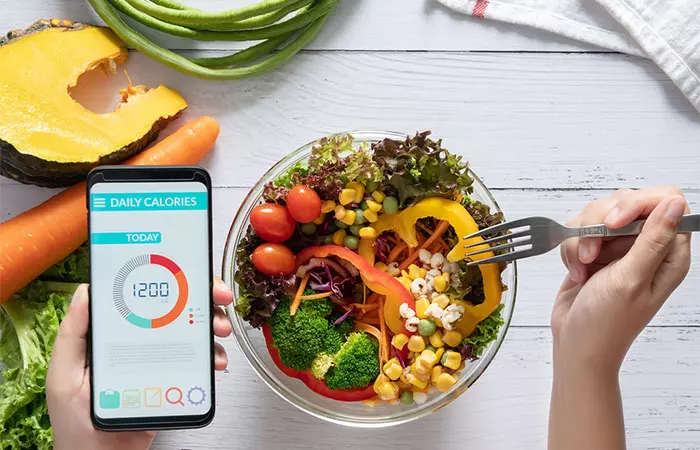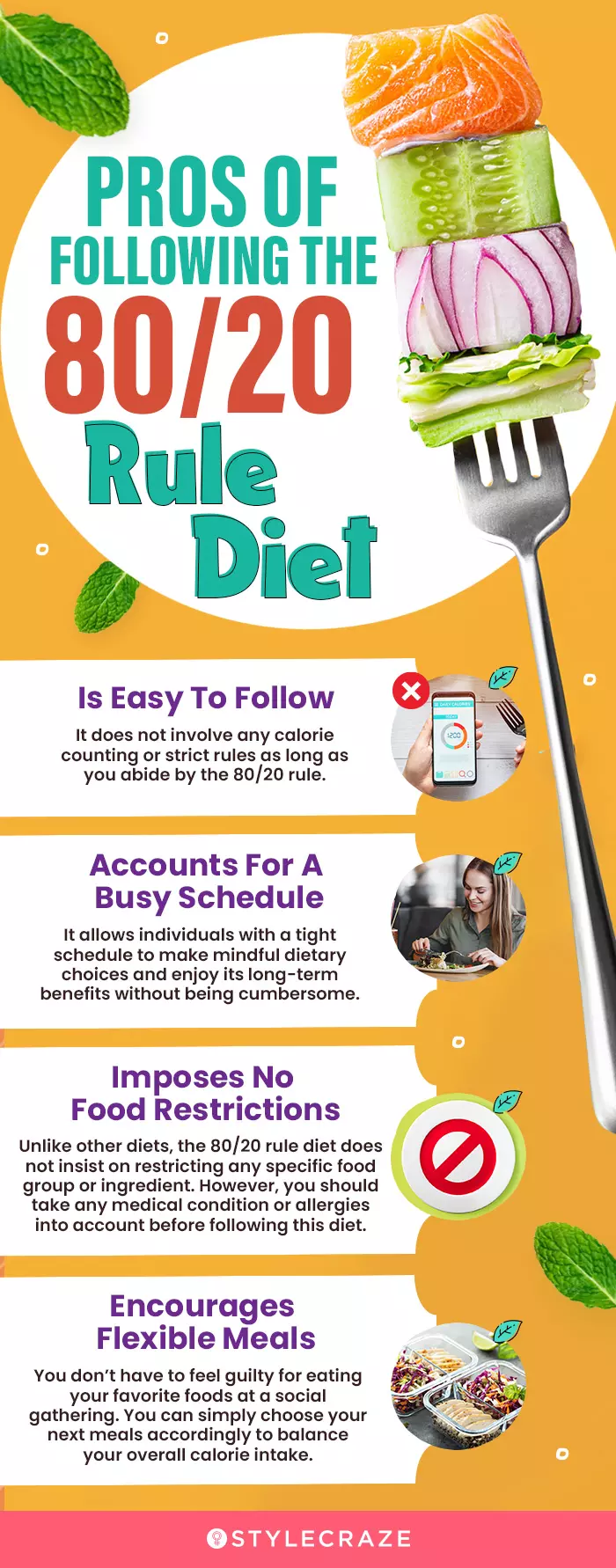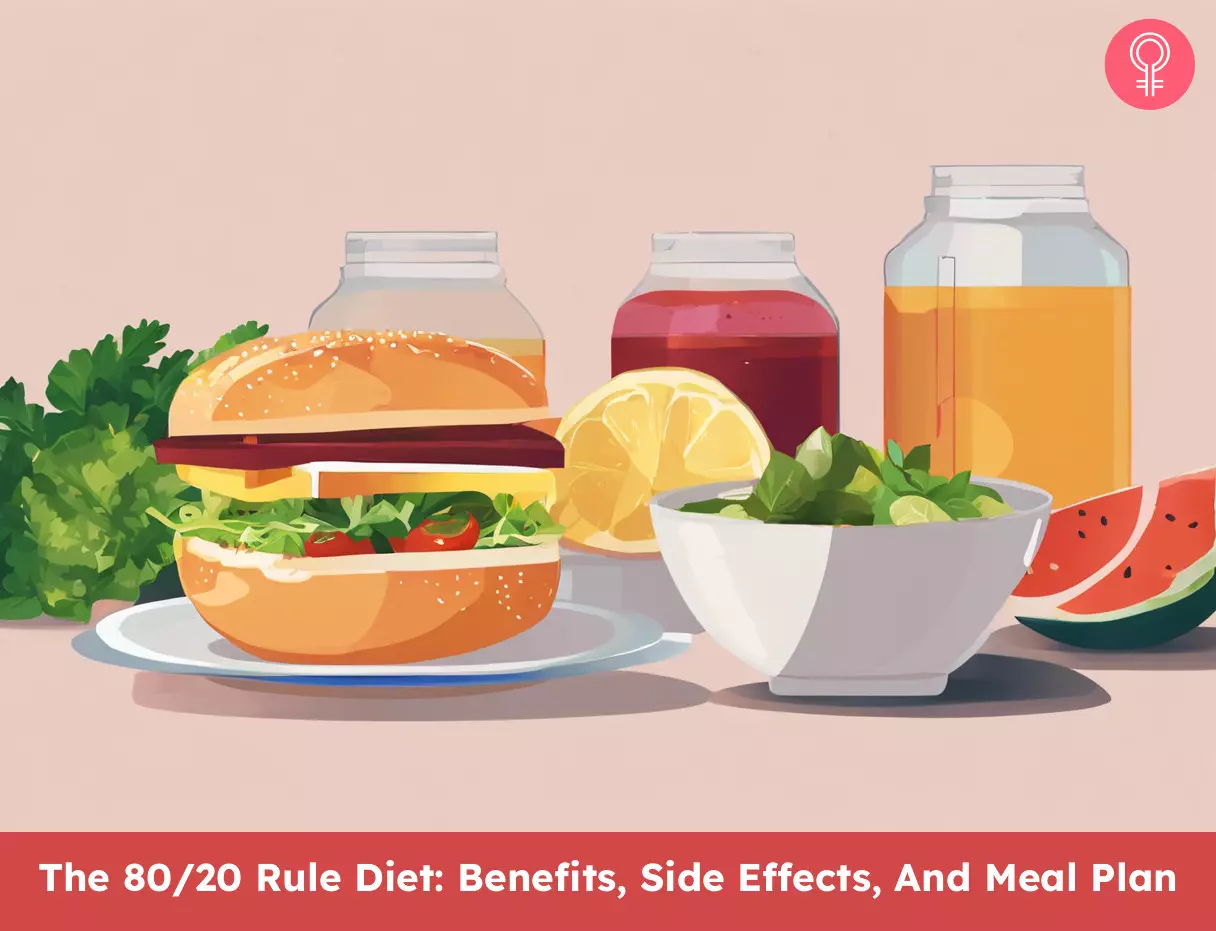Understanding these rules will help you get a better grip on your eating habits and achieve your health goals. Scroll down to learn more about the 80/20 rule diet, its benefits, and possible side effects, and what foods to eat.
What Is The 80/20 Rule Diet?
The 80/20 rule diet is not strictly a diet plan. It, instead, is a way of eating and a lifestyle where you consume nutritious meals 80% of the time and relax food restrictions the remaining 20% of the time. This method helps you adopt healthier eating habits and balances your nutritional requirements. As this diet promotes flexible food options, it can complement weight loss diets like the CICO diet which mainly focuses on calorie deficit, often overlooking nutrition. While how it is to be practiced is open to individual interpretation, this diet is also called the weekend diet as you can eat your favorite foods for two days after eating healthy foods for five days in a row. This idea goes against the theory of dieting, which can often cause side effects. One study notes that, in some cases, dieting may backfire and lead to binge eating (1). However, the 80/20 rule diet can save you from such restrictions as it offers a diverse menu. Mary Sabat, a Registered Dietitian, says, “It may be more suitable for weight maintenance as the 20% “cheats” will back fire for someone trying to lose weight.” A carefully planned 80/20 rule diet can give you the best of both worlds. Read more to learn how this diet can help you in your health journey.
How Does The 80/20 Rule Diet Work?
Balances Your Meals
The premise of the 80/20 rule diet is to welcome balanced and nutritious meals and snacks. It involves choosing unprocessed and whole foods such as fruits, vegetables, whole grains, lean proteins, and healthy fats for the majority of your diet (80% of the time).
Focuses On Moderate Intake Of Treats
It does not fully eliminate the consumption of fatty, sugary, and processed foods. Instead, the diet gives you the freedom to enjoy occasional treats (20% of the time) so that you do not lose control or slip back into unhealthy eating patterns. The 80/20 rule diet can be a favorable solution for individuals seeking sustainable healthy eating. But should you follow this diet? Keep reading to know more.
Who Should Follow The 80/20 Rule Diet?
The 80/20 eating practice is beneficial for individuals who are:
Looking for a realistic plan to stick to for the long term. Seeking a balanced diet that includes a variety of nutrient-dense foods with cheat days. Dealing with busy lifestyles that include social gatherings and celebrations that may involve unhealthy eating. Looking for ways to focus on mindful dietary choices. Athletes and fitness enthusiasts who want to have cheat meals without feeling guilty.
This diet can cater to different requirements of people and can be modified as per one’s needs. For example, the Ayurvedic diet promotes holistic wellness. So, integrating the 80/20 diet approach can allow individuals to maintain Ayurvedic principles while also enjoying some flexibility of modern dietary habits. Let us now look at some of its key benefits that make it sustainable.
Benefits Of The 80/20 Rule Diet
Is Easy To Follow
The 80/20 rule diet is a straightforward plan that does not involve calorie counting or strict rules. Its simplicity makes it easy to understand and incorporate into your life.
Has A Variety Of Food Choices
The diet plan encourages the intake of a diverse range of foods and does not restrict anything. Nutrient-dense foods ensure one’s overall well-being while cheat meals keep the journey enjoyable.
Does Not Exclude Food Groups
Unlike some restrictive diets, the 80/20 rule diet does not exclude particular food groups. It instead encourages moderation and portion control. This helps one form a healthy relationship with food.
Is Highly Adaptable
You get to enjoy foods that are not a part of your regular diet (the 80%) when you are at social gatherings. You just have to remember to balance your upcoming meals accordingly to maintain the 80/20 ratio. These features make this diet perfect for those who are new to dieting and want to start eating healthy. It can help kickstart your health journey and take you a step closer to your goal. That said, one of the most common goals of this diet is weight loss. But how well does it work for weight loss? We will discuss the same in the next section.
Does The 80/20 Rule Diet Work For Weight Loss?
The efficacy of the 80/20 rule diet plan for weight loss depends on various factors. A week-long healthy eating and abstinence from junk food may result in some weight loss, but there’s a catch – you may regain the lost weight over the weekend. A study published in the journal Obesity (Silver Spring) observes that changes in lifestyle (diet or activity-related) during the weekend may prevent weight loss. It concludes that higher energy intake over a short period, such as on weekends, could lead to significant weight gain (2). These findings may make the 80/20 rule diet seem a lot more appealing than effective. However, more research specific to its principles of healthy and balanced eating is warranted to arrive at any conclusion about its efficacy. Nevertheless, this diet can still serve as a starting point for those who are trying to break free from unhealthy eating patterns. Keep reading to discover ways to make the right calculations with respect to this diet.
How To Calculate The 80/20 Rule Diet
Remember that the 80/20 rule diet is not set in stone. You can modify it as per your requirements while eating nutritious meals 80% of the time and relaxing the restrictions the remaining 20% of the time. You can follow any of the following approaches.
Weekdays Versus Weekends
Eat foods rich in healthy fats, fiber, and minerals for five days of the week and your other favorite foods in the next two days. However, this approach may be counterproductive for some as it may lead to heavy calorie intake on weekends. You may prevent this by setting a few boundaries to keep yourself from binge eating in that short window.
Counting Total Number Of Meals Per Week
Divide the total number of meals in a 7-day week and distribute them in an 80/20 ratio. For example, breakfast, lunch, snack, and dinner make for 4 meals a day and 28 meals a week. So, you can have 22 healthy meals and 6 indulgent ones throughout the week.
Mixed Approach
Instead of eating a lot of junk food at a time, you may have it with every meal, and in moderation. Divide your daily calorie intake as per an 80/20 ratio. For example, if your daily caloric requirement is 1,600 calories, take 1,280 calories from healthy foods and the remaining 320 calories from other foods. You may also bend the rules and make it 90/10 to satisfy your cravings while limiting the intake of junk foods. The main idea is to keep your meals as healthy as possible 80% of the time so that you get to indulge the remaining 20% of the time without any guilt. However, you need to be aware of the differences between healthy and unhealthy or “indulgent” foods to make better choices. For example, while white bread is healthier than chips, it is less healthy than whole wheat bread as it has less fiber (3). Hence, your aim is to make your diet as healthy as possible by selecting more nutritious food options. Dive into the next section to learn about the right foods you can include in your 80/20 rule diet.
Foods To Eat On The 80/20 Rule Diet
Healthy foods refer to fruits and vegetables with minimal or no additives like sugars, fats, or salt (4), (5). These foods are rich in nutrients such as fiber, vitamins, and minerals that are essential for overall health. They also include whole grains, fat-free or low-fat dairy products, and lean meats. However, do watch your calorie intake to ensure you don’t overconsume calories even if they are coming from healthy foods. You may include the following healthy, low-calorie foods in your shopping list 80% of the time.
Sample Shopping List For The 80/20 Rule Diet
Fruits
Oranges Apples Watermelon Green grapes Cherries Berries Cantaloupe Pears Peaches Strawberries Grapefruit
Vegetables
Iceberg lettuce Green cabbage Celery Tomato Sweet Corn Onion Cucumber (with peel) Broccoli Carrot
Whole Grains
Wheat Barley Oats Brown rice Buckwheat
Lean Proteins
Skinless chicken breast Turkey Fish Tofu Lean beef Pork tenderloin Eggs (especially egg whites) Greek yogurt
Your Favorite Treats
Candies Cakes Pastries Patties Burger Pizza Cookies Ice cream
You might be tempted to gorge on your favorite foods once you finish 80% of your diet. But bear in mind that uncontrolled calorie intake during a short period may lead to unwanted weight gain. You can prevent that by following a proper meal plan. Check out the next section.
7-Day 80/20 Rule Diet Meal Plan
The following diet plan follows a mixed approach. You can eat any of your favorite foods as long as they do not exceed 300-350 calories (or any number of calories that constitute up to 20% of your daily intake). Also, make sure that 80% of your meals are super-nutritious and filling so that you don’t end up overindulging later. Every diet has pros and cons. While the benefits of the 80/20 rule diet grab all the attention, its side effects should not be overlooked. Let us now explore the potential downsides of this diet.
Side Effects Of The 80/20 Rule Diet
May Not Work For Everyone
The 80/20 rule diet is not a one-size-fits-all solution. It may not work for those who need to lose weight and have metabolic health conditions like diabetes, heart disease, etc. This is because processed foods pose dangers to human health (6).
Lacks Structure
The 80/20 rule diet can be too flexible as it lacks any fixed form or structure. This can make one end up overeating before they realize it.
May Lead To Binge Eating
A long, stressful week, staying too hungry, or the mere sight of your favorite foods can make you overeat. Binge-eating fatty and sugary foods, even just on the weekends, may make you gain weight and set back all the progress you may have made (2). Do I need to track my meals to follow the 80/20 rule diet? Typically, no meal tracking is involved in the 80/20 rule diet. However, you may need to count your number of meals, portions, and/or calories if you wish to nail the 80/20 ratio. Can the 80/20 rule diet lead to overindulgence? Yes, suppressing the urge to indulge in not-so-healthy foods for too long may lead to overindulgence. So, you may have at least one of your favorite foods every day to avoid this. Will I still get all the necessary nutrients with this approach? Yes. The 80/20 rule diet focuses on eating healthy through the majority of your meals. These healthy foods include fruits, vegetables, whole grains, and animal products that can offer essential nutrients. How can I make the 80/20 rule diet a sustainable habit? You can make the 80/20 rule diet a sustainable habit by: • Planning your meals • Controlling your portions • Enjoying its flexibility (as opposed to an all-or-none approach)
Illustration: The 8020 Rule Diet: Benefits Side Effects And Meal Plan
The 80/20 rule diet is popular because of its adaptability! All you have to do is distribute your healthy foods and indulgences in an 80/20 ratio, respectively. Quite simple, isn’t it? Watch the following video to learn how to work it out practically.












